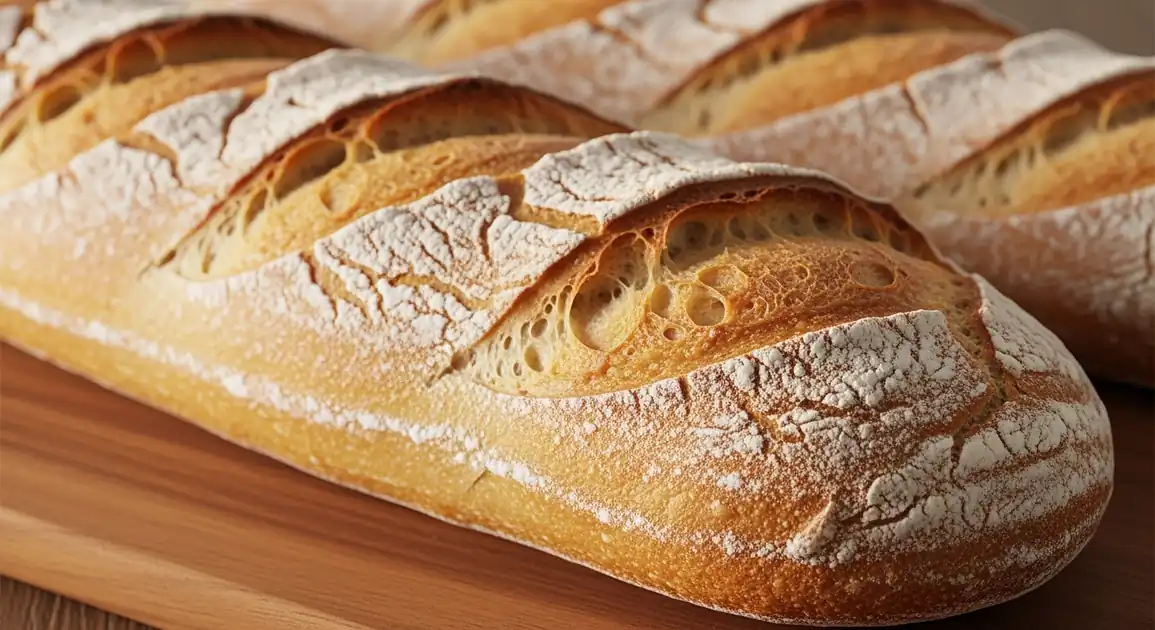Baguette Tradition
Baguette de Tradition Française

Description
Paris represents the pinnacle of Baguette Tradition craftsmanship, hosting the annual Grand Prix de la Baguette competition where bakers compete for the honor of supplying the French President at the Élysée Palace. The city boasts an exceptional concentration of master bakers (with many 'Meilleur Ouvrier de France' award winners) who maintain exacting standards. Parisians are particularly discerning bread consumers, creating a competitive environment that drives quality.
Dietary Information
Serving information
Serving style
In Paris, better bakeries use branded paper bags. The tradition is commonly enjoyed as part of the 'formule' sandwich at lunch, with butter and jam at breakfast, or alongside cheese and charcuterie for dinner.
Quick facts
Parisian bakeries typically open 7 AM - 8 PM Tuesday-Saturday, with limited Sunday morning hours (closed Sunday afternoon and all day Monday in many cases). Baking occurs throughout the day with major batches around 6 AM, 11 AM, and 4 PM.
Safety Tips
What to Look For
-
Bread baked on premises (look for 'Artisan Boulanger' sign)
Ensures authenticity and freshness. True artisan bakeries make dough and bake bread on site. Some shops merely bake pre-made industrial dough.
-
Proper fermentation indicated by irregular air holes in the crumb
Well-fermented dough creates varied hole sizes throughout the bread, indicating proper technique and better digestibility.
-
Distinctive crackling sound when crust is pressed gently
Called the bread's 'song' ('chant du pain'), this indicates optimal freshness and proper baking.
-
Variable appearance across baguettes (not identical)
Hand-shaped breads have natural variation. Too-perfect uniformity suggests industrial production.
-
Baker willing to discuss when bread was made and baking schedule
Transparent bakers proud of their craft will share when bread was baked and when next batches will be ready.
What to avoid
-
Perfectly uniform shape and appearance across multiple baguettes
Suggests industrial production methods rather than true artisanal crafting.
-
Pale, soft crust lacking deep golden or amber color
Indicates underbaking or improper oven conditions, affecting flavor and texture.
-
Dense, uniform interior without varied air pockets
Sign of insufficient fermentation time or improper technique, compromising digestibility and flavor.
-
Pre-sliced tradition baguettes
Quality compromises quickly after slicing. Better bakeries slice only upon request.
-
Very low prices (significantly under €1.30-€1.80)
True Tradition baguettes require more time and skill to produce, making them pricier than regular baguettes.
Price information
Price range
Budget tips
- Expect to pay €1.40-€2.20 for a quality Tradition in Paris, prices vary by neighborhood.
- Tourist areas charge premium prices; walk a few blocks into residential areas for better value.
- Some award-winning bakeries charge more (up to €2.20) but deliver exceptional quality.
- Ask for a 'demi-tradition' (half loaf) if you're alone, typically €0.80-€1.10.
- Morning-baked bread purchased in late afternoon might be slightly discounted at some bakeries.
Value indicators
- Award badges displayed (especially Grand Prix de la Baguette de Paris).
- Hand-shaped with distinctly slashed crust ('grignes').
- Noticeably different appearance from regular baguettes - more rustic.
- Strong wheaty aroma and complex flavor.
- Proper bake with caramelized, crackling crust.
- Elastic interior with well-developed irregular holes.
Where to Find This Dish
Saint-Germain-des-Prés (6th)
High concentration of award-winning artisanal bakeries catering to discerning locals.
Marché Saint-Germain, Église Saint-Germain-des-Prés
Morning (7 AM - 10 AM), Evening (5 PM - 7 PM)
Montmartre (18th)
Mix of tourist-oriented and authentic local bakeries. Seek those frequented by residents.
Place des Abbesses, Rue des Martyrs
Morning (8 AM - 11 AM)
Bastille/Marais (3rd/4th/11th)
Trendy areas with excellent artisanal bakeries attracting food-conscious Parisians.
Marché Bastille, Place des Vosges
Morning (8 AM - 11 AM), Afternoon (4 PM - 6 PM)
Rue Montorgueil Area (2nd)
Pedestrianized food street with several quality bakeries.
Rue Montorgueil market street
Midday (11 AM - 2 PM)
Vendor Tips
- Look for the annual Grand Prix de la Baguette de Paris award winners
- Bakeries with queues of locals (not just tourists) usually indicate quality
- In Paris, true artisanal bakeries close one day per week (often Monday) for rest
- Many top Parisian bakers make multiple batches throughout the day - ask when the next batch will be ready
How to Order
Regional Variations
-
Pain Parisien
(Pain Parisien)
A wider, shorter version of the tradition, with the same dough and qualities but a different shape.
-
Pavé Parisien
(Pavé Parisien)
Square-shaped tradition loaf favored by some Parisian bakers, offering more crumb to crust ratio.
-
Tradition Petrisane
(Tradition Pétrisane)
Method used by some Parisian bakers involving higher hydration and unique folding techniques for a more open crumb structure.
Cultural context
History
The Baguette Tradition emerged from the 1993 'Décret Pain' (Bread Decree), a response to industrialization threatening traditional French breadmaking. This legislation established strict standards for 'pain de tradition française,' protecting artisanal methods during a period when mass-produced, additive-laden baguettes were becoming common. The decree aimed to preserve authentic French bread culture, which has roots going back centuries but especially flourished after the French Revolution when wheat bread became accessible to all classes. Today, the tradition represents a return to pre-industrial breadmaking techniques, emphasizing quality, flavor complexity, and artisanal craftsmanship, helping revitalize France's bread heritage after decades of declining quality.
Local significance
In Paris, the Baguette Tradition symbolizes a return to quality after decades of industrialization. The annual Grand Prix competition elevated its status from everyday staple to culinary art form.
Eating customs
- Standing at café counters eating tartines (open-faced tradition with toppings).
- Breaking off the end piece ('quignon') to eat on the walk home.
- Slicing lengthwise for sandwiches, especially the iconic 'jambon-beurre'.